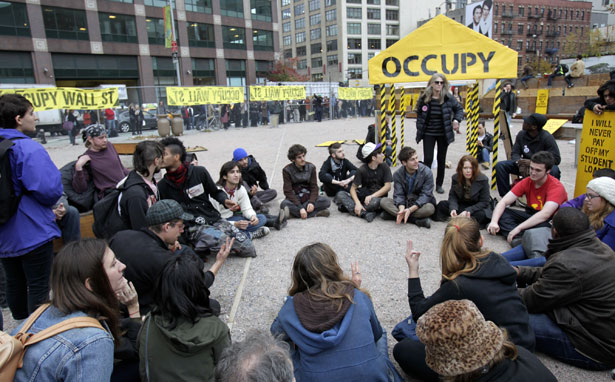
Occupy Wall Street protesters hold a general assembly meeting inside an enclosed site near Canal Street on Tuesday, November 15, 2011. (AP Photo/Seth Wenig)
At 9 am, the occupiers were bleary-eyed but full of fight. After a dramatic night, in which they were abruptly forced out of the park—while watching their possessions shoveled into a truck and their friends arrested or pepper-sprayed—they were beginning to get their energy back. About two hundred protesters gathered at the intersection of Canal and Sixth Avenue, and a group lifted themselves onto the top of a wall, where they sat, almost triumphantly, holding a banner that said, “OCCUPY WALL ST” and placards saying, “I will never pay off my student loans,” “I will never pay off my debt” and “I will never get a job in this economy.”
There were announcements that unions and representatives from faith-based organizations were on their way to meet the group and help them “find new real estate.” But instead of waiting, many people decided to go back to the park. Thanks to a temporary restraining order, drafted by the National Lawyers Guild and signed into effect by a judge at 6:30 am today, the protesters thought that they would be allowed to return to the park. The restraining order was set to last only until 11:30 am, and attorneys had gone to the State Supreme Court to ask for its extension.
But when protesters began returning to Zuccotti Park around 10 am, cops in riot gear had filled the plaza and put up barriers, prohibiting entry. Protesters tried asking the cops what right they had to prevent people from entering the park while the restraining order was in effect, but nobody found out the answer.
At the State Supreme Court House this afternoon, only a ten-minute walk from Zuccotti Park, Judge Michael Stallman listened to attorneys representing the Occupy Wall Street movement and representatives from Brookfield Properties, who owns Zuccotti Park. The main question for the judge was whether the eviction was a violation of First Amendment rights—and furthermore, whether the erection of tents and maintenance of generators in the park, which Brookfield Properties says they do not allow, is an essential aspect of the occupation’s right to free speech. The judge eventually denied the petitioners’ application to extend the restraining order, ruling that the occupiers had not "demonstrated that they have a First Amendment right to remain in Zuccotti Park, along with their tents, structures, generators, and other installations" and therefore did not hold the right to a restraining order.
Among the protesters, there were feelings of outrage mixed with a stubborn sense that the movement was moving forward, whether housed in Zuccotti Park or not.
A young man named Tim Weldon, who has been active in running a daily debate group in Zuccotti Park called Think Tank, said that he’d heard that Mayor Bloomberg had said, at a press conference that morning, that the protesters would now have to occupy the park only with their ideas. “What have we been doing all along?” said Weldon. “We’ve been here, discussing ideas about how to make the world a better place. Where has Mayor Bloomberg been?” He said that Think Tank would find a way to go on, even if they couldn’t hold it in the park.
“Mayor Bloomberg has been saying that we could stay here. But then he gave into his authoritarian temptations and kicked us out,” said Bill Dobbs, who has been involved with the Occupy Wall Street public relations working group, and has been at the park nearly every day over the past seven weeks.
“It’s too early to tell what will happen. This is a setback but we will regroup, continue organizing, and be stronger than ever,” Dobbs continued, as protesters swarmed around him, yelling, “Whose park? Our park?”
Outside the court house, 31-year-old Alejandro Varela, who is active in various OWS working groups and lives in Brooklyn, said that the park had mostly been a “survival mechanism” for the Occupy Wall Street movement. “It’s not essential that we have the park, but open space is essential. We’re going to have to spread out. But that’s something we wanted to do before this happened, anyway.”
Varela explained that physical space was a crucial factor in Occupy Wall Street’s ability to attract supporters. “We’re reclaiming the commons. These parks were designed as places to talk, to share ideas, perhaps over a meal.” He added that the location of Zuccotti Park in the financial district gave it a chance to send its message directly toward its intended recipient: Wall Street. “We disrupted ‘business as usual’ by being there,” he said. “We were a reminder that what Wall Street does is negative society.”
But with or without the park, most Occupy supporters do not appear ready to back down from the momentum the movement has gained through laborious organization, ongoing outreach and visible public actions. “No one piece of this movement is indispensable, except people—not even the park,” said Varela. “We need people most of all. Without the park, we’ll just have to be more creative.”


